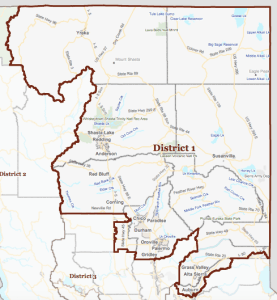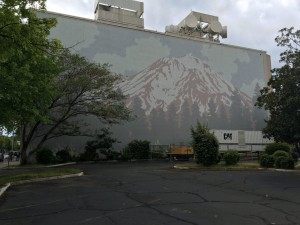REDDING, California — While radio hosts and political pundits in California speculate endlessly over the 2016 presidential primaries, the nitty-gritty battles are being fought in places like Shasta County, in the heart of the state’s first Congressional district.
The sprawling district reaches south from Oroville and Chico through the Sierra Nevada mountains and Cascades, all the way up to the Oregon border.
For the first time in decades, the last-in-the-nation June 7 primary in California will decide the 2016 general election nominees, for both the Republicans and the Democrats.
Breitbart News has predicted that Sen. Bernie Sanders (I-VT) will win most of the district’s six Democratic delegate. Because Democrats award their delegates, whose numbers vary based on the number of registered Democrats in each district, on a proportional basis, Hillary Clinton may also win a delegate or two.
But the contest will be particularly close among Republicans here, since the GOP awards three delegates per district on a winner-takes-all basis. That makes votes cast in the tony 33rd District in the Southland and in the working-class 1st District in the North equally important in determining who will emerge to carry the GOP mantle.
The geographic area of the first district is larger than some U.S. states. It spans 11 counties and boasts 377,000 registered voters, 40.6% of whom are registered Republicans. 29.3% are registered Democrats, while 22.9% express no party preference.
Sen. Ted Cruz and Donald Trump will square off in this reliably Republican swing district in what is expected to be one of the tightest races in the state primary. And with scant polling data, it is almost impossible at this early juncture to predict who will win here, though some are willing to try.
One poll in early March showed Donald Trump and Ted Cruz in a dead heat in the Sierra region.
“There are a fair number of Trump supporters here, and like elsewhere, they tend to be political outsiders who wouldn’t ordinarily participate in the process,” says Steve Gibson, news director for local radio station KQMS, and a Shasta County native. “But if I had to hazard a guess, I’d say this is Ted Cruz country.”
Gibson said that Cruz overwhelmingly came out on top in some informal polling done by his radio station, but those results couldn’t be counted upon to determine a favorite so far in advance of the primary.
“This is one of, if not the most, reliable Republican districts in the entire country,” explained Gibson. “The right wing is pretty far right, and the left wing is pretty far left.”
The district’s congressman, Republican Doug LaMalfa, endorsed Wisconsin governor Scott Walker early in the race. When he dropped out, LaMalfa endorsed Sen. Marco Rubio (R-FL). Now, LaMalfa is declining to endorse again.
“I’m done. I’m already 0-2,” he told the Los Angeles Times in March.
While it may be difficult to assess each candidate’s particular chances in the district, there is a wealth of demographic data that could help delineate the complex contours of the race here.
According to the most recent available Census data, the district is nearly 80 percent white, and 12 percent Hispanic. The unemployment rate is 9.2 percent, well above the national average. There are also a significant number of veterans living in the district, including more than 50,000 veterans with disabilities over the age of 65.
Agriculture, retail and health and social services are the dominant industries here; in 2014, the district’s median household income was $45,923.
But perhaps the single biggest factor could be the district’s high percentage of non-affiliated voters. In the “closed” California primary — in which registered voters of a particular party are barred from voting in the other party’s primary — the nearly 29 percent of voters who do not identify with a party could be a significant boon to Donald Trump, who has traditionally done well with this group — as long as they re-register as Republicans. (In California, Democrats allow “no party preference” voters to participate in their primary.)
At the Shasta County Republican Central Committee dinner on Thursday night, there was little talk of the Cruz-Trump rivalry. Instead, California Republican Party Chairman Jim Brulte called on the state Party to unite behind the eventual nominee.
“It’s going to be fun, because we actually matter,” Brulte said of this year’s election season. “I don’t remember a time in my life where we had as many qualified Republican candidates as we did when we started [the primary season]. We should be proud. Because the worst Republican that ran would be better than either Bernie or Hillary.”
Still, Brulte warned that without a change in Republicans’ strategy statewide, the Party could be doomed to indefinite electoral failure.
“The voter profile of California is changing, and we as a party have not reacted quickly enough to it and we are paying a terrible price,” he added. “As a party, we have to spend a lot less time talking to ourselves and a lot more time talking in communities where people aren’t necessarily Republican if we’re going to survive as a party in California.”
Republican Assemblyman Brian Dahle would not offer a prediction as to whether Cruz or Trump would carry the district, but said the race would undoubtedly be “exciting on both sides.” Dahle said he was interested in seeing how an expected surge in voter turnout could affect down-ticket races.
“It’s just exciting to see California back in the game,” he added.
Follow Daniel Nussbaum on Twitter: @dznussbaum




COMMENTS
Please let us know if you're having issues with commenting.